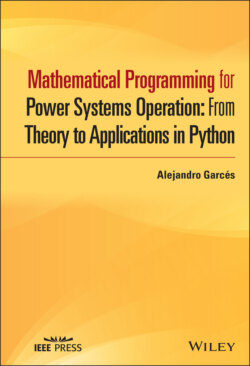Mathematical Programming for Power Systems Operation

Реклама. ООО «ЛитРес», ИНН: 7719571260.
Оглавление
Alejandro Garcés Ruiz. Mathematical Programming for Power Systems Operation
Mathematical Programming for Power Systems Operation. Mathematical Programming for Power Systems Operation. From Theory to Applications in Python
Contents
List of Illustrations
List of Tables
Guide
Pages
Acknowledgment
Introduction
1 Power systems operation
1.1 Mathematical programming for power systems operation
1.2 Continuous models. 1.2.1 Economic and environmental dispatch
1.2.2 Hydrothermal dispatch
1.2.3 Effect of the grid constraints
1.2.4 Optimal power flow
1.2.5 Hosting capacity
1.2.6 Demand-side management
1.2.7 Energy storage management
1.2.8 State estimation and grid identification
1.3 Binary problems in power systems operation
1.3.1 Unit commitment
1.3.2 Optimal placement of distributed generation and capacitors
1.3.3 Primary feeder reconfiguration and topology identification
1.3.4 Phase balancing
1.4 Real-time implementation
1.5 Using Python
Notes
2 A brief introduction to mathematical optimization
2.1 About sets and functions
Example 2.1
Example 2.2
Example 2.3
2.2 Norms
2.3 Global and local optimum
2.4 Maximum and minimum values of continuous functions
2.5 The gradient method
Example 2.4
Example 2.5
Example 2.6
Example 2.7
2.6 Lagrange multipliers
Example 2.8
2.7 The Newton’s method
Example 2.9
2.8 Further readings
2.9 Exercises
Notes
3 Convex optimization
3.1 Convex sets
Example 3.1
Example 3.2
Example 3.3
Example 3.4
Example 3.5
Example 3.6
Example 3.7
Example 3.8
3.2 Convex functions
Example 3.9
Example 3.10
Example 3.11
Example 3.12
3.3 Convex optimization problems
Example 3.13
Example 3.14
Example 3.15
Example 3.16
Example 3.17
3.4 Global optimum and uniqueness of the solution
3.5 Duality
Example 3.18
Example 3.19
Example 3.20
Example 3.21
3.6 Further readings
3.7 Exercises
Notes
4 Convex Programming in Python
4.1 Python for convex optimization
4.2 Linear programming
Example 4.1
Example 4.2
Example 4.3
Example 4.4
Example 4.5
4.3 Quadratic forms
Example 4.6
Example 4.7
4.4 Semidefinite matrices
Example 4.8
Example 4.9
Example 4.10
4.5 Solving quadratic programming problems
Example 4.11
Example 4.12
Example 4.13
4.6 Complex variables
Example 4.14
4.7 What is inside the box?
4.8 Mixed-integer programming problems
Example 4.15
Example 4.16
4.9 Transforming MINLP into MILP
Example 4.17
Example 4.18
4.10 Further readings
4.11 Exercises
Notes
5 Conic optimization
5.1 Convex cones
5.2 Second-order cone optimization
Example 5.1
Example 5.2
Example 5.3
Example 5.4
Example 5.5
5.2.1 Duality in SOC problems
5.3 Semidefinite programming
5.3.1 Trace, determinant, and the Shur complement
Example 5.6
Example 5.7
5.3.2 Cone of semidefinite matrices
Example 5.8
Example 5.9
Example 5.10
5.3.3 Duality in SDP
5.4 Semidefinite approximations
Example 5.11
Example 5.12
5.5 Polynomial optimization
Example 5.13
Example 5.14
5.6 Further readings
5.7 Exercises
Notes
6 Robust optimization
6.1 Stochastic vs robust optimization
6.1.1 Stochastic approach
6.1.2 Robust approach
6.2 Polyhedral uncertainty
Example 6.1
6.3 Linear problems with norm uncertainty
Example 6.2
6.4 Defining the uncertainty set
Example 6.3
Example 6.4
Example 6.5
Example 6.6
Example 6.7
Example 6.8
6.5 Further readings
6.6 Exercises
Notes
7 Economic dispatch of thermal units
7.1 Economic dispatch
Example 7.1
Example 7.2
Example 7.3
Example 7.4
Example 7.5
Example 7.6
7.2 Environmental dispatch
Example 7.7
Example 7.8
7.3 Effect of the grid
Example 7.9
Example 7.10
7.4 Loss equation
Example 7.11
7.5 Further readings
7.6 Exercises
Notes
8 Unit commitment
8.1 Problem definition
8.2 Basic unit commitment model
Example 8.1
8.3 Additional constraints
8.4 Effect of the grid
Example 8.2
8.5 Further readings
8.6 Exercises
9 Hydrothermal scheduling
9.1 Short-term hydrothermal coordination
9.2 Basic hydrothermal coordination
Example 9.1
9.3 Non-linear models
Example 9.2
9.4 Hydraulic chains
Example 9.3
9.5 Pumped hydroelectric storage
Example 9.4
9.6 Further readings
9.7 Exercises
Notes
10 Optimal power flow
10.1 OPF in power distribution grids
10.1.1 A brief review of power flow analysis
Example 10.1
Example 10.2
Example 10.3
Example 10.4
10.2 Complex linearization
Example 10.5
Example 10.6
10.2.1 Sequential linearization
Example 10.7
10.2.2 Exponential models of the load
Example 10.8
10.3 Second-order cone approximation
Example 10.9
Example 10.10
Example 10.11
10.4 Semidefinite approximation
Example 10.12
10.5 Further readings
10.6 Exercises
Notes
11 Active distribution networks
11.1 Modern distribution networks
11.2 Primary feeder reconfiguration
Example 11.1
11.3 Optimal placement of capacitors
Example 11.2
Example 11.3
11.4 Optimal placement of distributed generation
Example 11.4
11.5 Hosting capacity of solar energy
Example 11.5
11.6 Harmonics and reactive power compensation
Example 11.6
11.7 Further readings
11.8 Exercises
Notes
12 State estimation and grid identification
12.1 Measurement units
12.2 State estimation
Example 12.1
Example 12.2
12.3 Topology identification
Example 12.3
12.4 Ybus estimation
Example 12.4
Example 12.5
Example 12.6
12.5 Load model estimation
Example 12.7
Example 12.8
12.6 Further readings
12.7 Exercises
Notes
13 Demand-side management
13.1 Shifting loads
Example 13.1
Example 13.2
13.2 Phase balancing
Example 13.3
Example 13.4
13.3 Energy storage management
Example 13.5
13.4 Further readings
13.5 Exercises
Notes
A The nodal admittance matrix
Example A.1
Example A.2
Notes
B Complex linearization
Notes
C Some Python examples
C.1 Basic Python. Example C.1
Example C.2
Example C.3
Example C.4
Example C.5
Example C.6
Example C.7
Example C.8
Example C.9
C.2 NumPy
Example C.10
Example C.11
Example C.12
Example C.13
Example C.14
C.3 MatplotLib. Example C.15
C.4 Pandas
Example C.16
Bibliography
Index
WILEY END USER LICENSE AGREEMENT
Отрывок из книги
Alejandro GarcésTechnological University of PereiraPereira, Colombia
Alejandro Garcés
.....
The gradient of this function is presented below:
(2.32)
.....